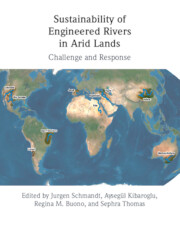Book contents
- Sustainability of Engineered Rivers in Arid Lands
- Sustainability of Engineered Rivers in Arid Lands
- Copyright page
- Dedication
- Contents
- Contributors
- Part I Introduction
- Part II Challenge
- 2 Global Climate Change and the Rivers
- 3 Reservoirs
- 4 Depletion of Groundwater
- 5 Endangered Food Security
- 6 Declining Environmental Flows
- Part III Engineered Rivers
- Part IV Response
- Part V Conclusion
- Index
- References
6 - Declining Environmental Flows
from Part II - Challenge
Published online by Cambridge University Press: 16 September 2021
- Sustainability of Engineered Rivers in Arid Lands
- Sustainability of Engineered Rivers in Arid Lands
- Copyright page
- Dedication
- Contents
- Contributors
- Part I Introduction
- Part II Challenge
- 2 Global Climate Change and the Rivers
- 3 Reservoirs
- 4 Depletion of Groundwater
- 5 Endangered Food Security
- 6 Declining Environmental Flows
- Part III Engineered Rivers
- Part IV Response
- Part V Conclusion
- Index
- References
Summary
This chapter discusses the impact of river engineering on natural flow regimes and the attendant effects on ecosystems. Changes in flow regimes have resulted in huge ecological change, including the creation of exotic species that replace or compete with the native species. Many rivers in arid regions have growing populations and economic activity dependent on their water supplies. Restoring natural flows may not be possible.
Keywords
- Type
- Chapter
- Information
- Sustainability of Engineered Rivers In Arid LandsChallenge and Response, pp. 66 - 76Publisher: Cambridge University PressPrint publication year: 2021

